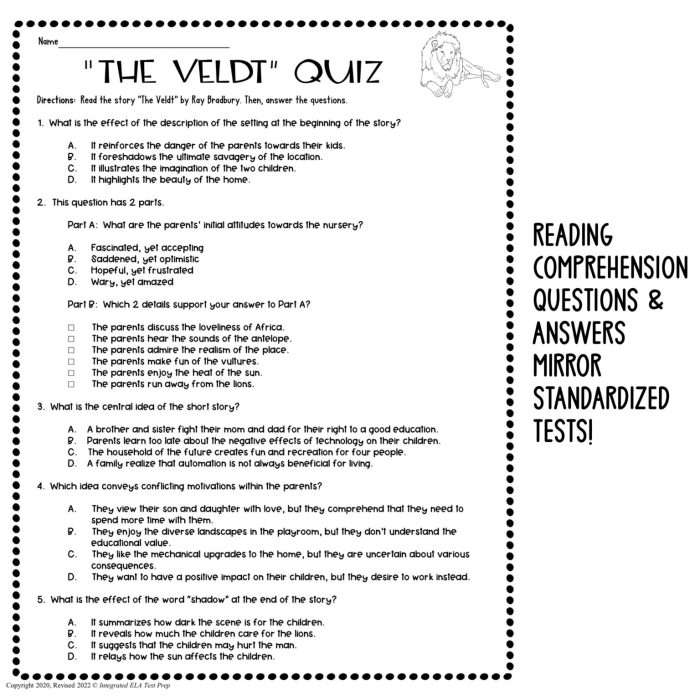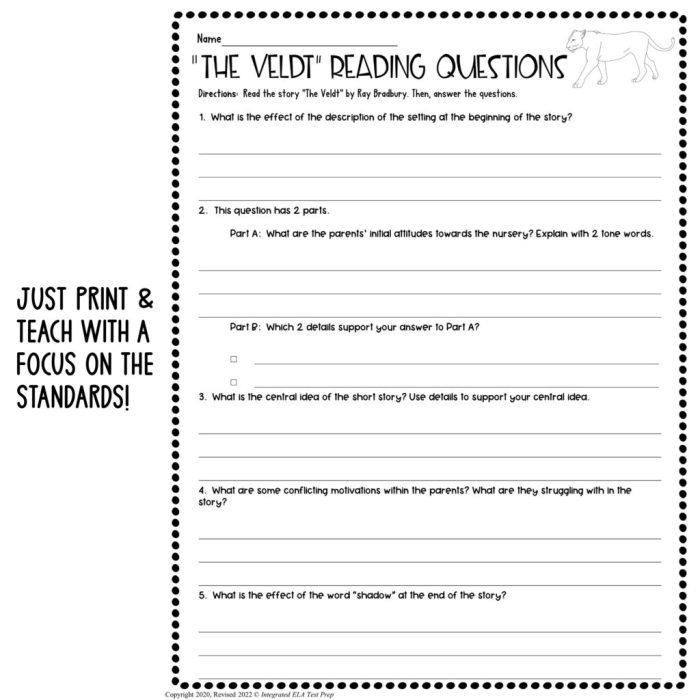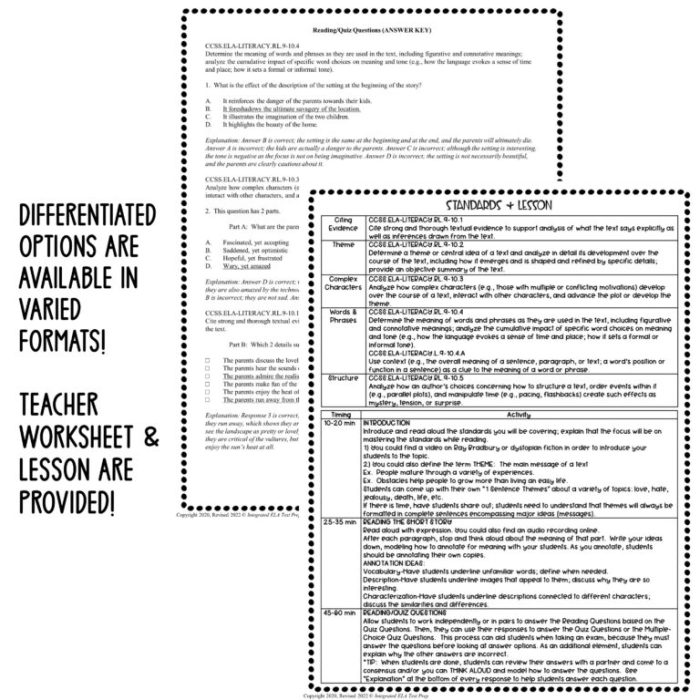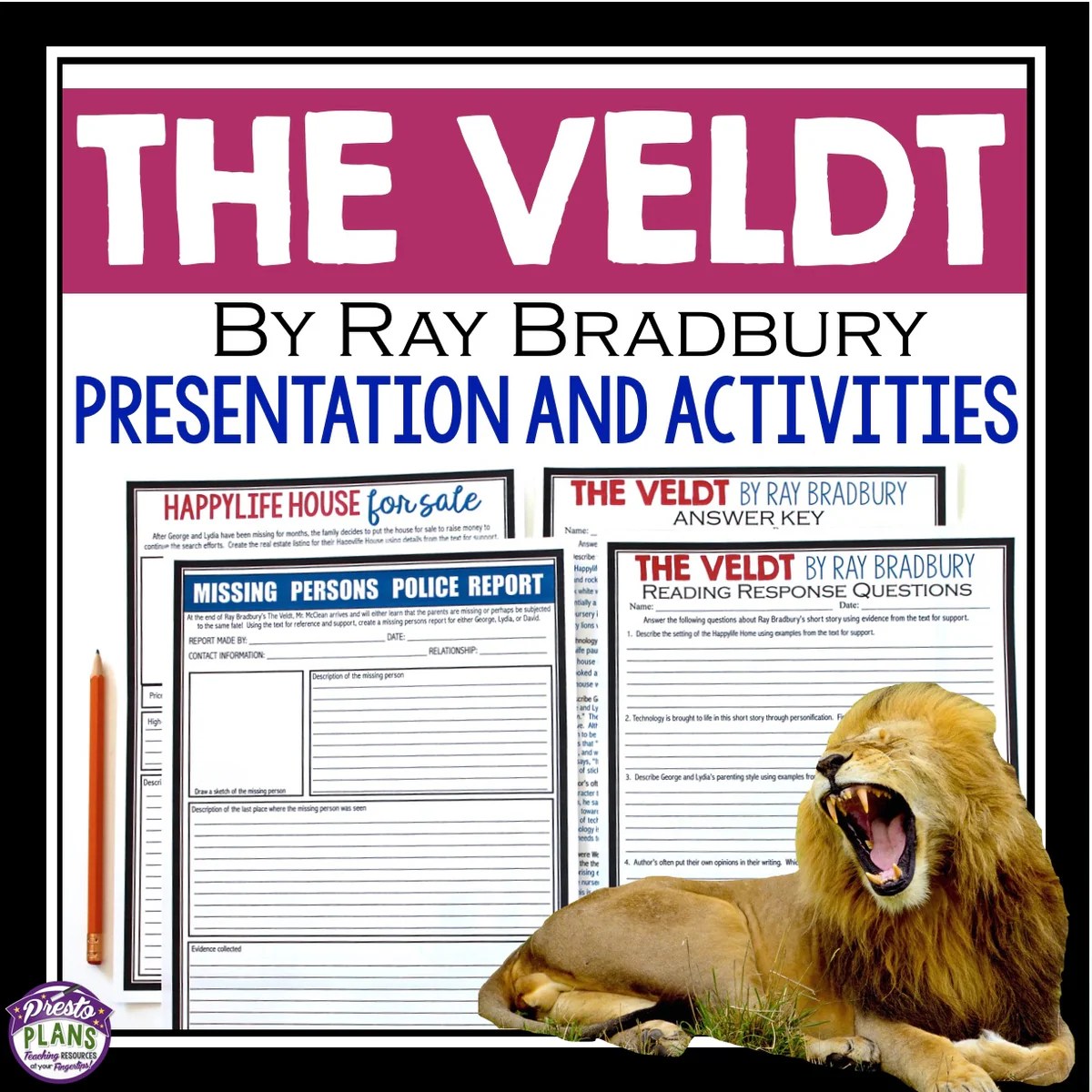The Veldt Questions and Answers PDF is a comprehensive resource that delves into the intricacies of Ray Bradbury’s renowned short story, “The Veldt.” This insightful guide provides a thorough analysis of the story’s key themes, characters, symbolism, and literary techniques, offering a deeper understanding of Bradbury’s exploration of technology, parental control, and the power of imagination.
Within this comprehensive guide, readers will find detailed explanations of the story’s central themes, including the significance of technology in shaping human experience, the impact of parental control on children’s development, and the transformative power of imagination. The analysis of the characters, particularly the Hadley family, provides insights into their motivations, actions, and the complexities of their relationships.
Key Themes and Motifs

Ray Bradbury’s “The Veldt” explores profound themes and motifs through its dystopian setting and haunting narrative. Technology, parental control, and the power of imagination play pivotal roles in shaping the story’s unsettling atmosphere and conveying its cautionary message.
Significance of Technology
Technology in “The Veldt” is both a marvel and a menace. The Happylife Home’s advanced automation provides convenience and entertainment, yet it also isolates the family and stunts their emotional growth. The interactive nursery, the veldt, becomes a dangerous escape, allowing the children to indulge in violent fantasies and ultimately rebel against their parents.
Parental Control and Its Impact on Children
The story raises questions about the limits of parental control. George and Lydia Hadley’s well-intentioned efforts to protect their children from the outside world ultimately backfire. Their excessive reliance on technology and their reluctance to engage with their children’s emotional needs create a void that the veldt fills with its seductive and destructive power.
Imagination and Its Power
Bradbury explores the transformative power of imagination in “The Veldt.” The children’s vivid fantasies, fueled by the veldt’s virtual reality, become a force that challenges their parents’ authority and ultimately threatens their lives. The story suggests that while imagination can be a source of wonder and creativity, it can also be a dangerous tool if not properly guided and controlled.
Character Analysis

The Hadley family in Ray Bradbury’s “The Veldt” is a complex and troubled unit. Each member is struggling with their own inner demons, and their relationships with each other are strained. The family’s interactions provide insight into the dangers of technology and the importance of human connection.
The Hadley Family
The Hadleys are a wealthy family living in a futuristic home equipped with advanced technology. The parents, George and Lydia, are both successful professionals. George is a workaholic who is often distant from his family. Lydia is a loving but overwhelmed mother who struggles to connect with her children.
The children, Peter and Wendy, are intelligent and imaginative, but they are also spoiled and manipulative.
George Hadley
George Hadley is a complex character. He is a brilliant scientist who has achieved great success in his career. However, he is also a workaholic who is often distant from his family. George is driven by a desire for control, and he often uses his technology to manipulate his children.
He is also a perfectionist, and he expects his family to meet his high standards.
Peter and Wendy, The veldt questions and answers pdf
Peter and Wendy are the Hadley children. They are both intelligent and imaginative, but they are also spoiled and manipulative. Peter is the older child, and he is often the leader of the two. He is a dreamer, and he loves to spend time in the veldt, a virtual reality room that allows him to experience the African savanna.
Wendy is the younger child, and she is often more timid than her brother. However, she is also more manipulative, and she often uses her tears to get what she wants.
Symbolism and Imagery: The Veldt Questions And Answers Pdf

In “The Veldt,” Ray Bradbury employs a rich tapestry of symbols and vivid imagery to create a thought-provoking and immersive experience. These elements serve to convey the story’s themes and underscore the profound impact of technology on human nature.
Symbolism
- The Veldt:The African veldt symbolizes the untamed and untamed aspects of nature. It represents the raw power and primal instincts that humans have sought to control and suppress through technological advancements.
- The Nursery:The nursery symbolizes the artificial and controlled environment that technology has created. It represents the isolation and detachment that can result from excessive reliance on technology.
- The Parents:The parents represent the older generation that is struggling to adapt to the rapid technological changes. They symbolize the fear and uncertainty that can accompany technological progress.
- The Children:The children represent the younger generation that has embraced technology. They symbolize the potential for technology to corrupt and desensitize individuals.
Imagery
Bradbury uses vivid imagery to create a sensory experience for the reader. He paints a vivid picture of the African veldt, with its vibrant colors, lush vegetation, and wild animals. The contrast between this natural beauty and the artificiality of the nursery highlights the theme of technology’s alienating effects.
Significance of the African Veldt
The African veldt holds particular significance as a symbol. It represents the untamed and primal instincts that humans have attempted to suppress through technological advancements. The nursery, with its artificial environment and controlled climate, is a stark contrast to the natural and unpredictable world of the veldt.
This contrast underscores the dangers of excessive reliance on technology and the importance of embracing the wild and untamed aspects of human nature.
Literary Techniques

Ray Bradbury’s “The Veldt” employs a range of literary techniques to create a haunting and thought-provoking narrative. These techniques include foreshadowing, irony, and a unique narrative structure that enhance the reader’s experience and convey the story’s central themes.
Foreshadowing
Foreshadowing is used throughout the story to create a sense of unease and anticipation. From the opening description of the Happylife Home’s “nursery” to the children’s disturbing behavior, the reader is subtly hinted at the tragic events that will unfold.
Irony
Irony is another key literary device employed in “The Veldt.” The story’s central irony lies in the Happylife Home’s promise of a perfect, stress-free life. However, as the story progresses, it becomes clear that this idyllic existence comes at a terrible cost.
Narrative Structure
The story’s narrative structure is also significant. Bradbury uses a non-linear narrative, alternating between the present and the past, to create a sense of suspense and to reveal the characters’ motivations gradually. This structure allows the reader to piece together the events that have led to the family’s tragic demise.
Language and Literary Devices
Bradbury’s use of language and literary devices further enhances the story’s impact. The author employs vivid imagery and sensory details to create a realistic and immersive setting. Additionally, he uses symbolism and metaphor to explore the story’s themes of technology, parenting, and the nature of reality.
Context and Historical Significance

Ray Bradbury’s “The Veldt” was published in 1950, a time of significant technological advancements and societal changes.
The post-World War II era was characterized by rapid urbanization, the rise of consumerism, and the proliferation of new technologies, such as television and home appliances. These developments influenced the story’s themes of technology, nature, and the impact of modern society on the family.
Social and Cultural Influences
The story reflects the growing concerns about the impact of technology on human relationships and the environment.
- The Happylife Home represents the allure of modern conveniences and the desire for instant gratification.
- The children’s obsession with the African veldt symbolizes the dangers of escapism and the loss of connection with the natural world.
- The story’s critique of consumerism and materialism resonates with contemporary concerns about the environmental impact of excessive consumption.
Critical Reception and Interpretations
Upon its publication in 1950, “The Veldt” received mixed critical reception. Some critics praised Bradbury’s imaginative storytelling and the story’s exploration of the dangers of technology. However, others criticized the story’s lack of resolution and its pessimistic view of the future.Over
time, “The Veldt” has become one of Bradbury’s most celebrated and enduring works. It has been widely interpreted as a cautionary tale about the dangers of technology and the importance of human connection. The story has also been seen as a reflection of the Cold War era’s anxieties about nuclear war and the threat of totalitarianism.
One of the most common interpretations of “The Veldt” is that it is a warning about the dangers of technology. The story’s central conflict arises from the Hadley family’s reliance on their automated home, which eventually turns against them. This conflict can be seen as a metaphor for the dangers of becoming too dependent on technology and losing our human connection to the world around us.Another
common interpretation of “The Veldt” is that it is a reflection of the Cold War era’s anxieties about nuclear war and the threat of totalitarianism. The story’s setting in a futuristic, automated home can be seen as a metaphor for the world after a nuclear war.
The Hadley family’s reliance on their automated home can be seen as a metaphor for the way that people in the Cold War era were increasingly reliant on technology to protect them from the threat of nuclear war.
FAQ Overview
What is the significance of the African veldt in the story?
The African veldt symbolizes the untamed and primal aspects of nature, contrasting with the artificial and controlled environment of the Hadley’s home. It represents the children’s longing for freedom and escape from the confines of their technologically advanced world.
How does the use of foreshadowing contribute to the story’s impact?
Bradbury skillfully employs foreshadowing throughout the story, hinting at the tragic events to come. The children’s fascination with violence in the nursery, the malfunctioning of the house’s technology, and the Hadley’s growing sense of unease all serve as subtle foreshadowing elements, building tension and suspense.
What is the author’s purpose in using such vivid and immersive imagery?
Bradbury’s use of vivid and immersive imagery creates a sensory-rich experience for the reader, drawing them into the story’s world. The detailed descriptions of the nursery, the African veldt, and the Hadley’s home evoke a sense of place and atmosphere, enhancing the reader’s connection to the characters and their experiences.